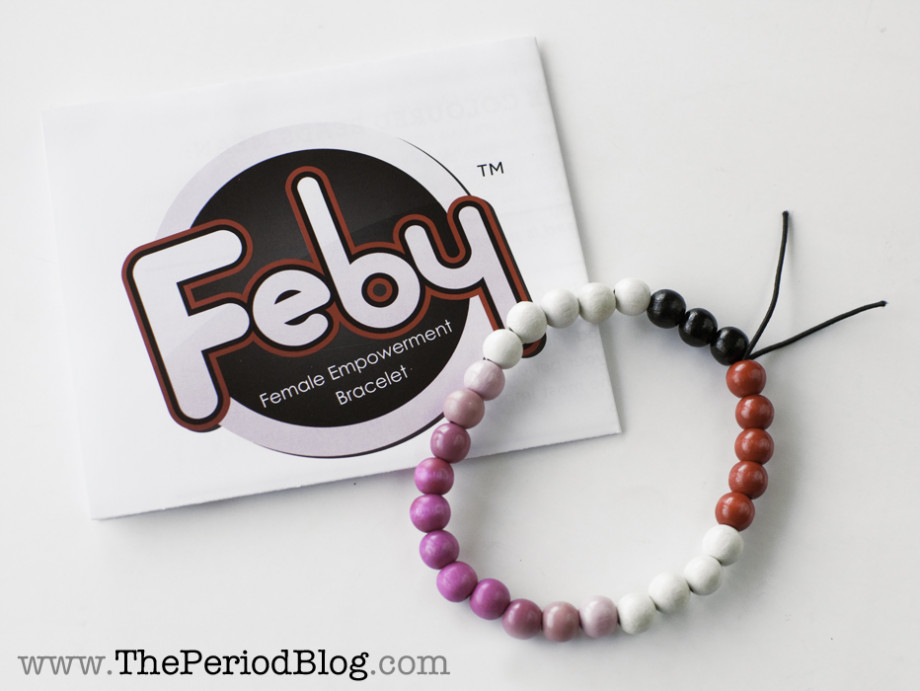In the Blog
Product Review: The Female Empowerment Bracelet
For many women, the menstrual cycle is a process that is complicated, unavoidable, and often annoying. But for the amount of time and money that women and girls spend on menstrual issues, many women don’t know the specifics of the cycle itself. Alison Sanchez, a Missisauga, ON-based entrepreneur, has created the Female Empowerment Bracelet as way for women to track the basic changes in their menstrual cycles. The bracelet, also called a Feby bracelet, has 28 beads that symbolize the different days of the cycle, and are coloured accordingly–black for pre-menstrual, red for menstruation, white for “neutral” and pink for ovulation. The beads are arranged in a pattern that matches the cycle itself. Each day, the wearer can move a knot in the bracelet’s string in between the beads, which helps to keep track of what day it is in her cycle. The 28-bead bracelet may not be useful for girls whose periods are shorter or longer than the average, but can provide a girl with a general sense of how her cycle works in relation to the average.
I was provided with a sample of Feby while manning the Shameless booth at the Word on the Street Festival, and decided to try it out. On her website, and during her visit to the Shameless booth, Sanchez says that Feby is intended to be an educational tool for girls and younger women who are beginning their periods. She also suggests that girls can use the bracelet colours as coded ways to discuss their periods with other girls, in order to feel more comfortable discussing their bodies. In this way, Feby can be both an educational and an interactive tool, especially for younger girls who are just beginning to learn about their unique experiences of the menstrual cycle.

Alison Sanchez’s Feby bracelet. http://www.theperiodblog.com/2012/03/feby-female-empowerment-bra
As Sanchez writes, and as I emphasize here, Feby bracelet should not be considered a substitute for teaching girls about menstruation and sexual health. It should be used as one part of a larger and more comprehensive teaching plan that allows girls to learn about themselves in both practical and theoretical ways.
Women, and especially young women and girls learning sexual education in schools, are not encouraged to explore their bodies for health or for pleasure. The rhetoric that surrounds menstruation in popular culture and in sexual education treats a period as if it were a shameful and gross event that “happens” to women at a certain time of the month. <a href=”(http://www.youtube.com/watch?v=VRfvCHRVmdY)>Tampon commercials and other aspects of pop culture encourage girls and women to treat their periods as an enemy. This approach does not allow for an exploration of menstrual products that help to deal with a period without pretending that it doesn’t exist. �x2028
Feby offers an interesting way to bridge the gap by making the wearer think about what her body is doing on a given day. After trying out Feby, I found that it had a similar effect to first using a DivaCup. Like Feby, the DivaCup is designed to provide “the opportunity to learn about your monthly flow, educating and empowering you about your body and your health.” In both cases, I thought much more about my body and how it went through the motions of a menstrual cycle, in a way that didn’t feel medical or unsanitary. This seems simple in theory, but it is actually a much more profound practice than it appears. It is much easier to ignore our bodies than it is to engage with them in a way that acknowledges their strengths and weaknesses without attempting to alter our abilities for better or for worse. If the menstrual cycle is normalized among younger girls through the use of tools like Feby, it is more likely that girls will be able to better express their opinions and feelings about their health and sexuality later in life.
The Feby website uses testimonials and blog posts that emphasize sisterhood, conversation, and empowerment. These aspects of the site are a little corny for my taste–empowerment and sisterhood are presented as fun activities rather than as political pursuits, which can undermine the seriousness of reproductive rights issues. Feby’s reliance on a colour system may also discourage younger women from openly talking about the physical and emotional aspects of each stage of the menstrual cycle as part of the “empowerment” process. The colour code system can be useful for younger women and girls who may not feel as comfortable with the clinical terminology of sex education and women’s health. So while the bracelet may indicate that one is in the “white” stage of the cycle, the wearer can check the guide online or in a booklet and understand that this is the stage in which estrogen levels rise and an egg is released from the ovum. However, considering that the target audience for the product skews towards teens and pre-teens, it makes more sense to market the product as something that is interesting and exciting, rather than a conscious political choice.
Ultimately, for those young women who felt distanced from their bodies during puberty, the Feby bracelet can provide a tool for feeling a bit more in control over what is “happening” to them, and perhaps make the whole process a little less mystifying.
The bracelet is available online for $6.95.



